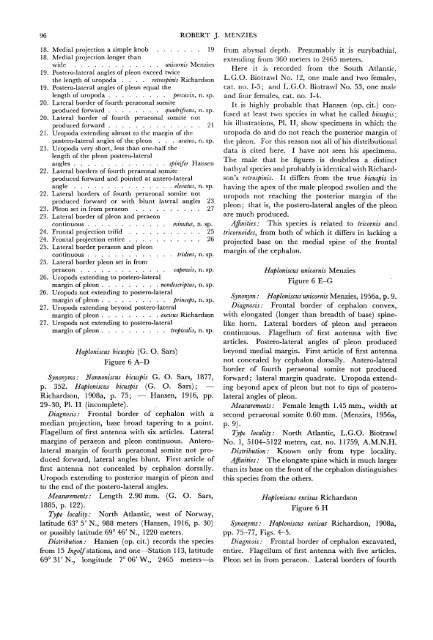The Isopods of Abyssal Depths in the Atlantic Ocean
The Isopods of Abyssal Depths in the Atlantic Ocean
The Isopods of Abyssal Depths in the Atlantic Ocean
You also want an ePaper? Increase the reach of your titles
YUMPU automatically turns print PDFs into web optimized ePapers that Google loves.
96 ROBERT J. MENZIES<br />
18. Medial projection a simple knob 19<br />
18. Medial projection longer than<br />
wide unicornis Menzies<br />
19. Postero-lateral angles <strong>of</strong> pleon exceed twice<br />
<strong>the</strong> length <strong>of</strong> uropoda . . . . retrosp<strong>in</strong>is Richardson<br />
19. Postero-lateral angles <strong>of</strong> pleon equal <strong>the</strong><br />
length <strong>of</strong> uropoda percavix, n. sp.<br />
20. Lateral border <strong>of</strong> fourth peraeonal somite<br />
produced forward quadrifrons, n. sp.<br />
20. Lateral border <strong>of</strong> fourth peraeonal somite not<br />
produced forward 21<br />
21. Uropoda extend<strong>in</strong>g almost to <strong>the</strong> marg<strong>in</strong> <strong>of</strong> <strong>the</strong><br />
postero-lateral angles <strong>of</strong> <strong>the</strong> pleon . . . acutus, n. sp.<br />
21. Uropoda very short, less than one-half <strong>the</strong><br />
length <strong>of</strong> <strong>the</strong> pleon postero-lateral<br />
angles sp<strong>in</strong>ifer Hansen<br />
22. Lateral borders <strong>of</strong> fourth peraeonal somite<br />
produced forward and po<strong>in</strong>ted at antero-lateral<br />
angle elevatus, n. sp.<br />
22. Lateral borders <strong>of</strong> fourth peraeonal somite not<br />
produced forward or with blunt lateral angles 23<br />
23. Pleon set <strong>in</strong> from peraeon 27<br />
23. Lateral border <strong>of</strong> pleon and peraeon<br />
cont<strong>in</strong>uous m<strong>in</strong>utus, n. sp.<br />
24. Frontal projection trifid 25<br />
24. Frontal projection entire 26<br />
25. Lateral border peraeon and pleon<br />
cont<strong>in</strong>uous tridens, n. sp.<br />
25. Lateral border pleon set <strong>in</strong> from<br />
peraeon capensis, n. sp.<br />
26. Uropods extend<strong>in</strong>g to postero-lateral<br />
marg<strong>in</strong> <strong>of</strong> pleon nondescriptus, n. sp.<br />
26. Uropods not extend<strong>in</strong>g to postero-lateral<br />
marg<strong>in</strong> <strong>of</strong> pleon pr<strong>in</strong>ceps, n. sp.<br />
27. Uropods extend<strong>in</strong>g beyond postero-lateral<br />
marg<strong>in</strong> <strong>of</strong> pleon excisus Richardson<br />
27. Uropods not extend<strong>in</strong>g to postero-lateral<br />
marg<strong>in</strong> <strong>of</strong> pleon tropicalis, n. sp.<br />
Haploniscus bicuspis (G. O. Sars)<br />
Figure 6 A-D<br />
Synonyms: Nannoniscus bicuspis G. O. Sars, 1877,<br />
p. 352. Haploniscus bicuspis (G. O. Sars); —<br />
Richardson, 1908a, p. 75; — Hansen, 1916, pp.<br />
29-30, PI. II (<strong>in</strong>complete).<br />
Diagnosis: Frontal border <strong>of</strong> cephalon with a<br />
median projection, base broad taper<strong>in</strong>g to a po<strong>in</strong>t.<br />
Flagellum <strong>of</strong> first antenna with six articles. Lateral<br />
marg<strong>in</strong>s <strong>of</strong> peraeon and pleon cont<strong>in</strong>uous. Anterolateral<br />
marg<strong>in</strong> <strong>of</strong> fourth peraeonal somite not produced<br />
forward, lateral angles blunt. First article <strong>of</strong><br />
first antenna not concealed by cephalon dorsally.<br />
Uropods extend<strong>in</strong>g to posterior marg<strong>in</strong> <strong>of</strong> pleon and<br />
to <strong>the</strong> end <strong>of</strong> <strong>the</strong> postero-lateral angles.<br />
Measurements: Length 2.90 mm. (G. O. Sars,<br />
1885, p. 122).<br />
Type locality: North <strong>Atlantic</strong>, west <strong>of</strong> Norway,<br />
latitude 63° 5' N., 988 meters (Hansen, 1916, p. 30)<br />
or possibly latitude 69° 46' N., 1220 meters.<br />
Distribution: Hansen (op. cit.) records <strong>the</strong> species<br />
from 15 Ingolf stations, and one—Station 113, latitude<br />
69°31'N., longitude 7° 06'W., 2465 meters—is<br />
from abyssal depth. Presumably it is eurybathial,<br />
extend<strong>in</strong>g from 360 meters to 2465 meters.<br />
Here it is recorded from <strong>the</strong> South <strong>Atlantic</strong>,<br />
L.G.O. Biotrawl No. 12, one male and two females,<br />
cat. no. 1-5; and L.G.O. Biotrawl No. 53, one male<br />
and four females, cat. no. 1-4.<br />
It is highly probable that Hansen (op. cit.) confused<br />
at least two species <strong>in</strong> what he called bicuspis:<br />
his illustrations, PI. II, show specimens <strong>in</strong> which <strong>the</strong><br />
uropoda do and do not reach <strong>the</strong> posterior marg<strong>in</strong> <strong>of</strong><br />
<strong>the</strong> pleon. For this reason not all <strong>of</strong> his distributional<br />
data is cited here. I have not seen his specimens.<br />
<strong>The</strong> male that he figures is doubtless a dist<strong>in</strong>ct<br />
bathyal species and probably is identical with Richardson's<br />
retrosp<strong>in</strong>is. It differs from <strong>the</strong> true bicuspis <strong>in</strong><br />
hav<strong>in</strong>g <strong>the</strong> apex <strong>of</strong> <strong>the</strong> male pleopod swollen and <strong>the</strong><br />
uropods not reach<strong>in</strong>g <strong>the</strong> posterior marg<strong>in</strong> <strong>of</strong> <strong>the</strong><br />
pleon; that is, <strong>the</strong> postero-lateral angles <strong>of</strong> <strong>the</strong> pleon<br />
are much produced.<br />
Aff<strong>in</strong>ities: This species is related to tricornis and<br />
tricornoides, from both <strong>of</strong> which it differs <strong>in</strong> lack<strong>in</strong>g a<br />
projected base on <strong>the</strong> medial sp<strong>in</strong>e <strong>of</strong> <strong>the</strong> frontal<br />
marg<strong>in</strong> <strong>of</strong> <strong>the</strong> cephalon.<br />
Haploniscus unicornis Menzies<br />
Figure 6 E-G<br />
Synonym: Haploniscus unicornis Menzies, 1956a, p. 9.<br />
Diagnosis: Frontal border <strong>of</strong> cephalon convex,<br />
with elongated (longer than breadth <strong>of</strong> base) sp<strong>in</strong>elike<br />
horn. Lateral borders <strong>of</strong> pleon and peraeon<br />
cont<strong>in</strong>uous. Flagellum <strong>of</strong> first antenna with five<br />
articles. Postero-lateral angles <strong>of</strong> pleon produced<br />
beyond medial marg<strong>in</strong>. First article <strong>of</strong> first antenna<br />
not concealed by cephalon dorsally. Antero-lateral<br />
border <strong>of</strong> fourth peraeonal somite not produced<br />
forward; lateral marg<strong>in</strong> quadrate. Uropoda extend<strong>in</strong>g<br />
beyond apex <strong>of</strong> pleon but not to tips <strong>of</strong> posterolateral<br />
angles <strong>of</strong> pleon.<br />
Measurements: Female length 1.45 mm., width at<br />
second peraeonal somite 0.60 mm. (Menzies, 1956a,<br />
p. 9).<br />
Type locality: North <strong>Atlantic</strong>, L.G.O. Biotrawl<br />
No. 1, 5104-5122 meters, cat. no. 11759, A.M.N.H.<br />
Distribution: Known only from type locality.<br />
Aff<strong>in</strong>ities: <strong>The</strong> elongate sp<strong>in</strong>e which is much larger<br />
than its base on <strong>the</strong> front <strong>of</strong> <strong>the</strong> cephalon dist<strong>in</strong>guishes<br />
this species from <strong>the</strong> o<strong>the</strong>rs.<br />
Haploniscus excisus Richardson<br />
Figure 6 H<br />
Synonyms: Haploniscus excisus Richardson, 1908a,<br />
pp. 75-77, Figs. 4-5.<br />
Diagnosis: Frontal border <strong>of</strong> cephalon excavated,<br />
entire. Flagellum <strong>of</strong> first antenna with five articles.<br />
Pleon set <strong>in</strong> from peraeon. Lateral borders <strong>of</strong> fourth

















